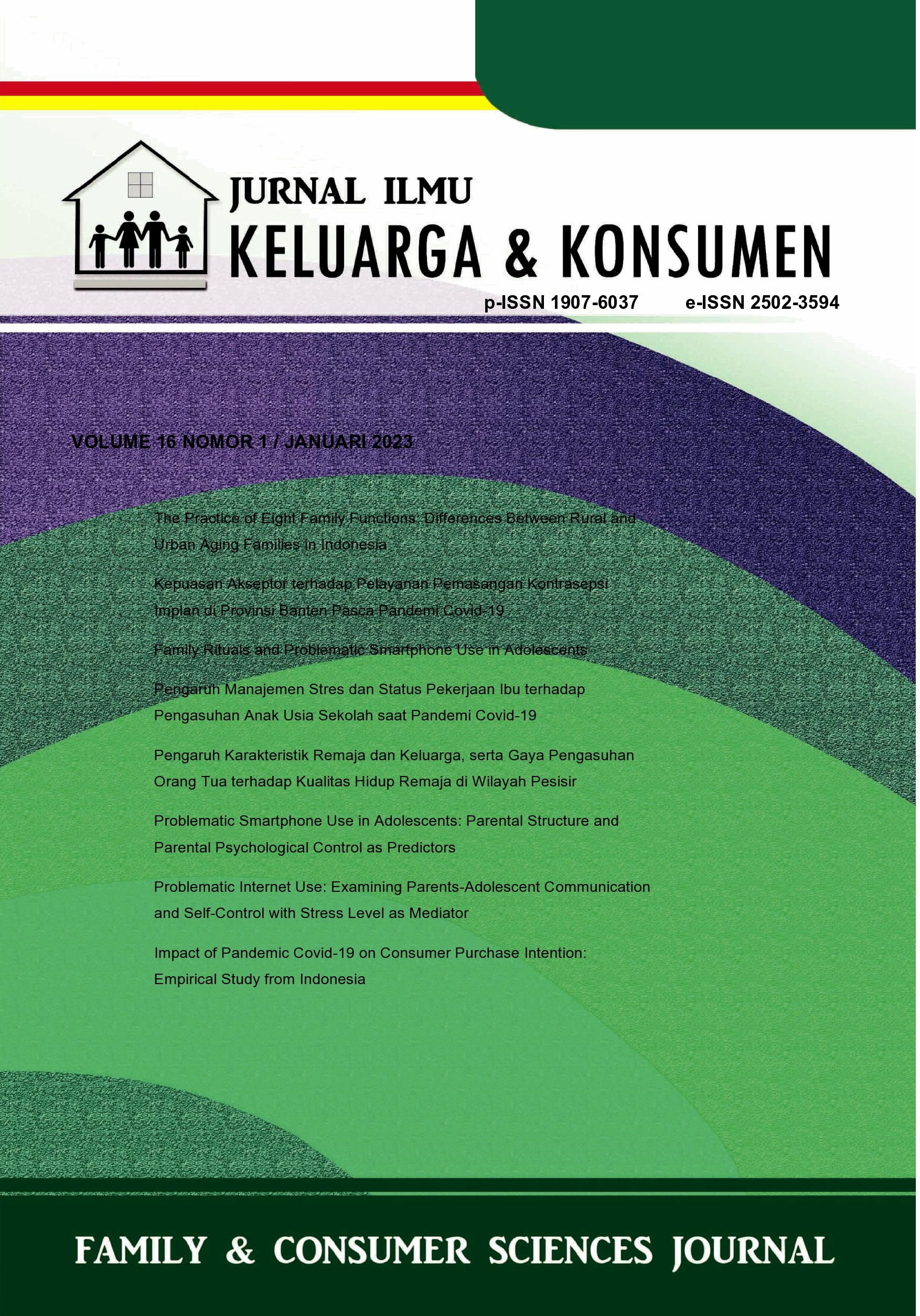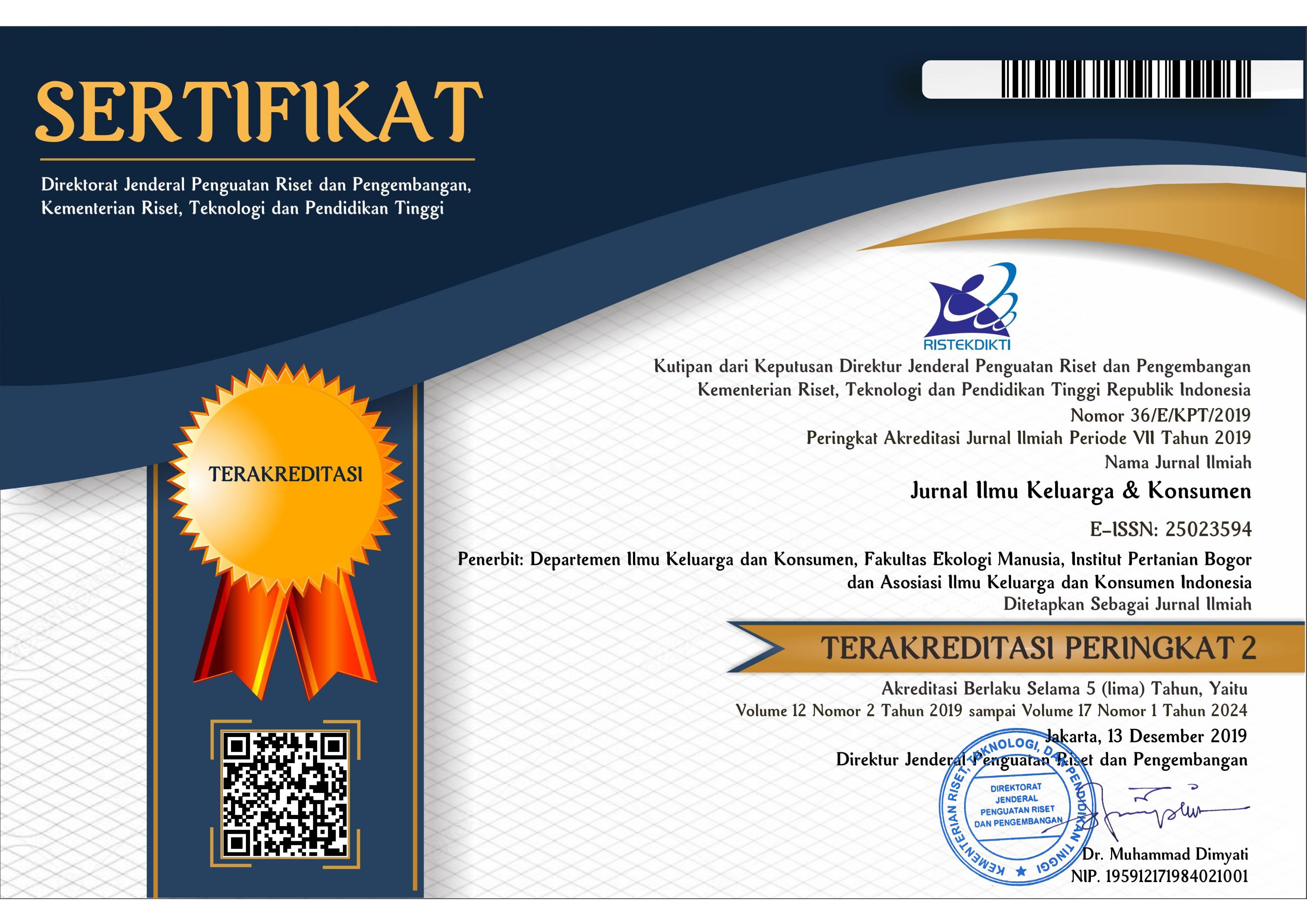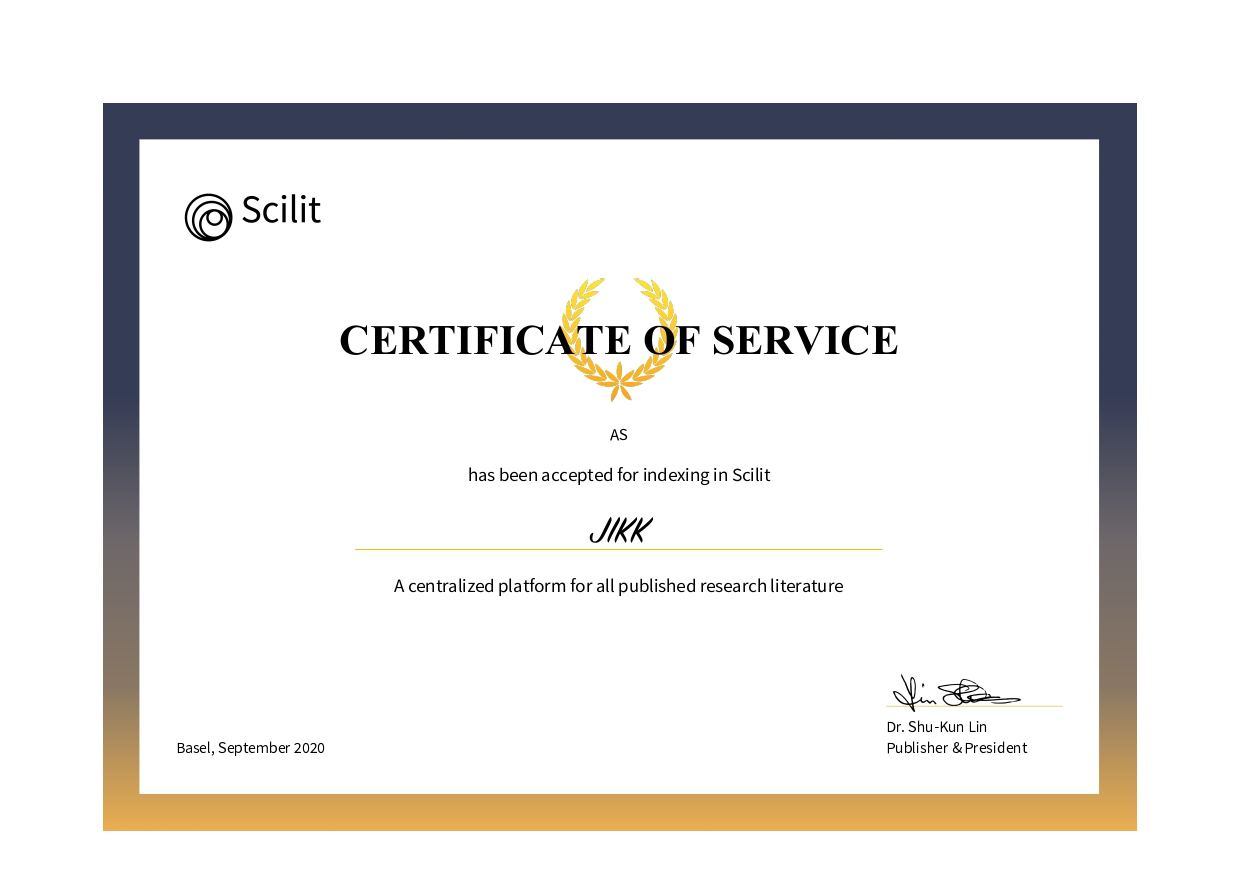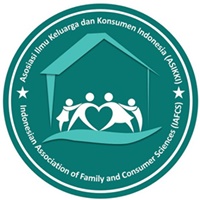PROBLEMATIC SMARTPHONE USE IN ADOLESCENTS: PARENTAL STRUCTURE AND PARENTAL PSYCHOLOGICAL CONTROL AS PREDICTORS
Abstract
The use of smartphones in adolescents can negatively impact their daily lives. When adolescents’ ability to control smartphone use is low, they could experience problematic smartphone use behavior (PSU). By internalizing control, parents play a crucial role in enhancing adolescents' self-control on smartphone use. Based on the controlling component of parenting, there are two types of parental control: parental structure and parental psychological control. Previous studies have found a relationship between parental psychological control and PSU. However, studies investigating the relationship between parental structure and parental psychological control simultaneously with PSU are limited. This study is important since parents found practicing those two types of parental control simultaneously. Therefore, this study aimed to investigate the effect of parental structure and psychological control on adolescents' problematic smartphone use. 219 adolescents aged 12-18 (M = 14.49 years) completed the Indonesian version of the Parental Structure Scale, Parental Psychological Control Scale, and Mobile Phone Problematic Use Scale questionnaires. Stepwise regression analysis shows that only parental psychological control predicts the increase of problematic smartphone use in adolescents. Our finding suggested that the type of parental control that emphasizes authority assertion, love withdrawal, and guilt induction is ineffective in decreasing problematic smartphone use in adolescents.
References
Abidin, F. A., Joefiani, P., Koesma, R. E., & Siregar, J. (2019). Parental structure and autonomy support: keys to satisfy adolescent’s basic psychological needs. Opción: Revista de Ciencias Humanas y Sociales, (22), 1257-1274.
Badan pusat statistik. (2021). Proporsi individu yang menguasai/memiliki telepon genggam menurut kelompok umur (Persen), 2019-2021. Retrieved from https://www.bps.go.id/indicator/27/1222/1/proporsi-individu-yang-menggunakan-telepon-genggam-menurut-kelompok-umur.html
Barber, B. K. (1996). Parental psychological control: Revisiting a neglected construct. Child Development, 67(6), 3296. https://doi.org/10.2307/1131780
Billieux, J. (2012). Problematic use of the mobile phone: A literature review and a pathways model. Current Psychiatry Reviews, 8(4), 299–307. https://doi.org/10.2174/157340012803520522
Boers, E., Afzali, M. H., Newton, N., & Conrod, P. (2019). Association of screen time and depression in adolescence. JAMA Pediatrics, 173(9), 853. https://doi.org/10.1001/jamapediatrics.2019.1759
Busch, P. A., & McCarthy, S. (2021). Antecedents and consequences of problematic smartphone use: A systematic literature review of an emerging research area. Computers in Human Behavior, 114, 106414. https://doi.org/10.1016/j.chb.2020.106414
Chang, F. C., Chiu, C. H., Chen, P. H., Chiang, J. T., Miao, N. F., Chuang, H. Y., & Liu, S. (2019). Children’s use of mobile devices, smartphone addiction and parental mediation in Taiwan. Computers in Human Behavior, 93, 25–32. https://doi.org/10.1016/j.chb.2018.11.048
Costa, S., Soenens, B., Gugliandolo, M. C., Cuzzocrea, F., & Larcan, R. (2014). The mediating role of experiences of need satisfaction in associations between parental psychological control and internalizing problems: A study among Italian college students. Journal of Child and Family Studies, 24(4), 1106–1116. https://doi.org/10.1007/s10826-014-9919-2
de-Sola, J., Talledo, H., Rodríguez de Fonseca, F., & Rubio, G. (2017). Prevalence of problematic cell phone use in an adult population in Spain as assessed by the mobile phone problem use scale (MPPUS). PLOS ONE, 12(8), e0181184. https://doi.org/10.1371/journal.pone.0181184
Elhai, J. D., Gallinari, E. F., Rozgonjuk, D., & Yang, H. (2020). Depression, anxiety and fear of missing out as correlates of social, non-social and problematic smartphone use. Addictive Behaviors, 105, 106335. https://doi.org/10.1016/j.addbeh.2020.106335
Farkas, M. S., & Grolnick, W. S. (2010). Examining the components and concomitants of parental structure in the academic domain. Motivation and Emotion, 34(3), 266–279. https://doi.org/10.1007/s11031-010-9176-7
Fischer-Grote, L., Kothgassner, O. D., & Felnhofer, A. (2019). Risk factors for problematic smartphone use in children and adolescents: A review of existing literature. Neuropsychiatrie, 33(4), 179–190. https://doi.org/10.1007/s40211-019-00319-8
Flamm, E. S., & Grolnick, W. S. (2013). Adolescent adjustment in the context of life change: The supportive role of parental structure provision. Journal of Adolescence, 36(5), 899–912. https://doi.org/10.1016/j.adolescence.2013.07.006
Gerwin, R. L., Kaliebe, K., & Daigle, M. (2018). The interplay between digital media use and development. Child and Adolescent Psychiatric Clinics of North America, 27(2), 345–355. https://doi.org/10.1016/j.chc.2017.11.002
González-Cámara, M., Osorio, A., & Reparaz, C. (2019). Measurement and function of the control dimension in parenting styles: A systematic review. International Journal of Environmental Research and Public Health, 16(17), 3157. https://doi.org/10.3390/ijerph16173157
Grolnick, W. S., & Pomerantz, E. M. (2009). Issues and challenges in studying parental control: Toward a new conceptualization. Child Development Perspectives, 3(3), 165–170. https://doi.org/10.1111/j.1750-8606.2009.00099.x
Grolnick, W. S., Raftery-Helmer, J. N., Flamm, E. S., Marbell, K. N., & Cardemil, E. V. (2014). Parental provision of academic structure and the transition to middle school. Journal of Research on Adolescence, 25(4), 668–684. https://doi.org/10.1111/jora.12161
Harris-McKoy, D. (2016). Adolescent delinquency: Is too much or too little parental control a problem? Journal of Child and Family Studies, 25(7), 2079–2088. https://doi.org/10.1007/s10826-016-0383-z
Hong, W., Liu, R. D., Ding, Y., Wang, J., Jiang, R., & Jiang, S. (2021). Self-esteem level and smartphone use in Chinese adolescents: the role of self-esteem stability. Current Psychology. https://doi.org/10.1007/s12144-021-01543-8
Horwood, S., & Anglim, J. (2019). Problematic smartphone usage and subjective and psychological well-being. Computers in Human Behavior, 97, 44–50. https://doi.org/10.1016/j.chb.2019.02.028
Hwang, Y., & Jeong, S. H. (2015). Predictors of parental mediation regarding children’s smartphone use. Cyberpsychology, Behavior, and Social Networking, 18(12), 737–743. https://doi.org/10.1089/cyber.2015.0286
International Test Commission. (2017). ITC guidelines. In The ITC Guidelines for Translating and Adapting Tests.
Kalhori, S. M., Mohammadi, M. R., Alavi, S. S., Jannatifard, F., Sepahbodi, G., Reisi, M. B., … Kasvaee, V. H. (2015). Validation and psychometric properties of mobile phone problematic use scale (MPPUS) in university students of Tehran. Iranian Journal of Psychiatry, 10(1), 25.
Kim, R., Lee, K. J., & Choi, Y. J. (2015). Mobile phone overuse among elementary school students in Korea. Journal of Addictions Nursing, 26(2), 81–85. https://doi.org/10.1097/jan.0000000000000074
Kwon, M., Kim, D. J., Cho, H., & Yang, S. (2013). The smartphone addiction scale: Development and validation of a short version for adolescents. PLoS ONE, 8(12), e83558. https://doi.org/10.1371/journal.pone.0083558
Lee, E. J., & Kim, H. S. (2021). Effect of maternal factors on problematic smartphone use among elementary school children. International Journal of Environmental Research and Public Health, 18(17), 9182. https://doi.org/10.3390/ijerph18179182
Lee, S. J., Lee, C., & Lee, C. (2016). Smartphone addiction and application usage in Korean adolescents: Effects of mediation strategies. Social Behavior and Personality: An International Journal, 44(9), 1525–1534. https://doi.org/10.2224/sbp.2016.44.9.1525
Li, X., Li, D., & Newman, J. (2013). Parental behavioral and psychological control and problematic internet use among Chinese adolescents: The mediating role of self-control. Cyberpsychology, Behavior, and Social Networking, 16(6), 442–447. https://doi.org/10.1089/cyber.2012.0293
Mangialavori, S., Russo, C., Jimeno, M. V., Ricarte, J. J., D’Urso, G., Barni, D., & Cacioppo, M. (2021). Insecure attachment styles and unbalanced family functioning as risk factors of problematic smartphone use in Spanish young adults: A relative weight analysis. European Journal of Investigation in Health, Psychology and Education, 11(3), 1011–1021. https://doi.org/10.3390/ejihpe11030075
Marciano, L., & Camerini, A. (2021). Recommendations on screen time, sleep and physical activity: associations with academic achievement in Swiss adolescents. Public Health, 198, 211–217. https://doi.org/10.1016/j.puhe.2021.07.027
Neophytou, E., Manwell, L. A., & Eikelboom, R. (2019). Effects of excessive screen time on neurodevelopment, learning, memory, mental health, and neurodegeneration: A scoping review. International Journal of Mental Health and Addiction, 19(3), 724–744. https://doi.org/10.1007/s11469-019-00182-2
Patton, G. C., Sawyer, S. M., Santelli, J. S., Ross, D. A., Afifi, R., Allen, N. B., Arora, M., Azzopardi, P., Baldwin, W., Bonell, C., Kakuma, R., Kennedy, E., Mahon, J., McGovern, T., Mokdad, A. H., Patel, V., Petroni, S., Reavley, N., Taiwo, K., … Viner, R. M. (2016). Our future: A lancet commission on adolescent health and wellbeing. The Lancet, 387(10036), 2423–2478. https://doi.org/10.1016/s0140-6736(16)00579-1
Polit, D. F., & Beck, C. T. (2006). The content validity index: are you sure you know what’s being reported? Critique and recommendations. Research in Nursing & Health, 29(5), 489–497. https://doi.org/10.1002/nur.20147
Radwan, N. L., Ibrahim, M. M., & Mahmoud, W. S. E. D. (2020). Evaluating hand performance and strength in children with high rates of smartphone usage: an observational study. Journal of Physical Therapy Science, 32(1), 65–71. https://doi.org/10.1589/jpts.32.65
Ratelle, C. F., Duchesne, S., Guay, F., & Boisclair Châteauvert, G. (2018). Comparing the contribution of overall structure and its specific dimensions for competence-related constructs: a bifactor model. Contemporary Educational Psychology, 54, 89–98. https://doi.org/10.1016/j.cedpsych.2018.05.005.
Rosič, J., Janicke-Bowles, S. H., Carbone, L., Lobe, B., & Vandenbosch, L. (2022). Positive digital communication among youth: the development and validation of the digital flourishing scale for adolescents. Frontiers in Digital Health, 4. https://doi.org/10.3389/fdgth.2022.975557
Schaeffer, K. (2019). Most U.S. teens who use cellphones do it to pass time, connect with others, learn new things. Pew Research Center. https://www.pewresearch.org/fact-tank/2019/08/23/most-u-s-teens-who-use-cellphones-do-it-to-pass-time-connect-with-others-learn-new-things/
Seo, D. G., Park, Y., Kim, M. K., & Park, J. (2016). Mobile phone dependency and its impacts on adolescents’ social and academic behaviors. Computers in Human Behavior, 63, 282–292. https://doi.org/10.1016/j.chb.2016.05.026
Shek, D. T. L., Zhu, X., & Ma, C. M. S. (2018). The influence of parental control and parent-child relational qualities on adolescent internet addiction: a 3-year longitudinal study in Hong Kong. Frontiers in Psychology, 9. https://doi.org/10.3389/fpsyg.2018.00642
Siste, K., Suwartono, C., Nasrun, M. W., Bardosono, S., Sekartini, R., Pandelaki, J., Sarasvita, R., Murtani, B. J., Damayanti, R., & Wiguna, T. (2019). Validation study of the Indonesian internet addiction test among adolescents. PLOS ONE, 16(2), e0245833. https://doi.org/10.1371/journal.pone.0245833
Siste, K., Suwartono, C., Nasrun, M. W., Bardosono, S., Sekartini, R., … Wiguna, T. (2021). Validation study of the Indonesian internet addiction test among adolescents. PLOS ONE, 16(2), e0245833. https://doi.org/10.1371/journal.pone.0245833
Sun, J., Liu, Q., & Yu, S. (2019). Child neglect, psychological abuse and smartphone addiction among Chinese adolescents: The roles of emotional intelligence and coping style. Computers in Human Behavior, 90, 74–83. https://doi.org/10.1016/j.chb.2018.08.032
Tateno, M., Kato, T. A., Shirasaka, T., Kanazawa, J., Ukai, W., & Hirota, T. (2022). A network analysis of problematic smartphone use in Japanese young adults. PLOS ONE, 17(8), e0272803. https://doi.org/10.1371/journal.pone.0272803
Twenge, J. M., Spitzberg, B. H., & Campbell, W. K. (2019). Less in-person social interaction with peers among U.S. adolescents in the 21st century and links to loneliness. Journal of Social and Personal Relationships, 36(6), 1892–1913. https://doi.org/10.1177/0265407519836170
Vaterlaus, J. M., Aylward, A., Tarabochia, D., & Martin, J. D. (2021). “A smartphone made my life easier”: An exploratory study on age of adolescent smartphone acquisition and well-being. Computers in Human Behavior, 114, 106563. https://doi.org/10.1016/j.chb.2020.106563
Viner, R. M., Ozer, E. M., Denny, S., Marmot, M., Resnick, M., Fatusi, A., & Currie, C. (2012). Adolescence and the social determinants of health. The Lancet, 379(9826), 1641–1652. https://doi.org/10.1016/s0140-6736(12)60149-4
Wang, D., Nie, X., Zhang, D., & Hu, Y. (2022). The relationship between parental psychological control and problematic smartphone use in early Chinese adolescence: A repeated-measures study at two time-points. Addictive Behaviors, 125, 107142. https://doi.org/10.1016/j.addbeh.2021.107142
Wang, Q., Pomerantz, E. M., & Chen, H. (2007). The role of parents’ control in early adolescents’ psychological functioning: a longitudinal investigation in the US and China. Child Development, 78, 1592-1610.
Wolniewicz, C. A., Tiamiyu, M. F., Weeks, J. W., & Elhai, J. D. (2018). Problematic smartphone use and relations with negative affect, fear of missing out, and fear of negative and positive evaluation. Psychiatry Research, 262, 618–623. https://doi.org/10.1016/j.psychres.2017.09.058
Yang, Z., Asbury, K., & Griffiths, M. D. (2018). An exploration of problematic smartphone use among Chinese university students: associations with academic anxiety, academic procrastination, self-regulation and subjective wellbeing. International Journal of Mental Health and Addiction, 17(3), 596–614. https://doi.org/10.1007/s11469-018-9961-1
Yao, X., Wu, J., Guo, Z., Yang, Y., Zhang, M., Zhao, Y., & Kou, Y. (2021). Parental psychological control and adolescents’ problematic mobile phone use: The serial mediation of basic psychological need experiences and negative affect. Journal of Child and Family Studies. https://doi.org/10.1007/s10826-021-02169-x
Zakiyyah, A., & Latifah, M. (2022). Pengaruh kelekatan remaja-orangtua, harga diri, dan kontrol diri terhadap penggunaan internet bermasalah pada remaja. Jurnal Ilmu Keluarga dan Konsumen, 15(3), 264–275. https://doi.org/10.24156/jikk.2022.15.3.264
Zhang, M. X., Zhou, H., Yang, H. M., & Wu, A. M. S. (2021). The prospective effect of problematic smartphone use and fear of missing out on sleep among Chinese adolescents. Current Psychology. https://doi.org/10.1007/s12144-021-01863-9
Copyright (c) 2023 Jurnal Ilmu Keluarga & Konsumen

This work is licensed under a Creative Commons Attribution-ShareAlike 4.0 International License.
Authors submitting manuscripts should understand and agree that copyright of manuscripts published are held Jurnal Ilmu Keluarga dan Konsumen. The statement to release the copyright to Jurnal Ilmu Keluarga dan Konsumen is stated in Copyright Release Form. Copyright encompass exclusive rights to reproduce, to distribute, and to sell any part of the journal articles in all form and media. The reproduction of any part of this journal is allowed with a written permission from Jurnal Ilmu Keluarga dan Konsumen.










